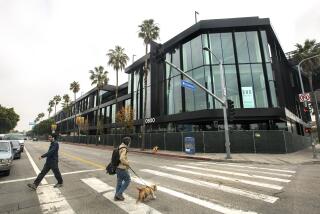Azusa Pacific Has Big Plans
- Share via
After spending the last two decades raising its academic profile, the once obscure Azusa Pacific University is embarking on an ambitious $550-million expansion that promises to remake its two main campuses.
The Azusa City Council approved on Monday the college’s plan to build out the university, split into an east campus and a nearby west campus and set near trailer parks and strips malls. The process is expected to take 20 years.
Money must be raised to pay for construction, so groundbreaking won’t begin for two more two years, said Mark Dickerson, the university’s general counsel.
As part of the plan, the nonprofit Christian institution has agreed to pay an annual fee to offset increased costs of city services associated with the growth.
The school’s plans include new classrooms and dormitories, as well as additional buildings for nursing, education, fine arts and student services.
Several parking structures will replace the existing lots, which will be torn up to make way for school buildings or open space, Dickerson said.
The expansion is necessary, Dickerson said, because student enrollment has doubled in the last decade to almost 6,000 students at its Azusa campuses, with 2,500 more attending the school’s satellite branches in Southern California.
The expansion will allow the campuses in Azusa to accommodate an additional 2,500 students, he said.
“The demand for college educations in California is far outstripping the capacity, and there’s an even higher demand for Christian education,” Dickerson said.
“I think it’s beneficial to have a university in your city,” Mayor Diane Chagnon said. “You can go to school from pre-kindergarten through your doctorate and live in a nice place, all in one city.”
The school was established in 1899 in Whittier, where it was first known as the Training School for Christian Workers. The first Bible college founded on the West Coast, it originally had just 12 students. Over the next several decades, it merged with other Christian schools in Southern California.
The school moved to Azusa in 1946 and held classes in bungalows on dusty fields when the town was a working-class outpost on Route 66, making its money from travelers and citrus groves. The college was known for decades as an institution focused more on tent revivals than academics.
But in the 1990s, Azusa Pacific College initiated its first fundraising campaign and its first doctoral programs, becoming Azusa Pacific University. It gained national accreditation for its teaching program in 2001, and now offers 22 master’s programs and six doctoral programs.
The university was featured last year in Time magazine, and was selected this year as one of the nation’s top small colleges by U.S. News & World Report.
Nestled in the foothills of the San Gabriel Mountains, Azusa Pacific is surrounded by vestiges of its past.
As a result of the school’s history of building as funds become available, the two Azusa campuses are a collection of parking lots and low-slung stucco bungalows next to more modern two- and three-story buildings.
Nearby are fast-food restaurants, trailer parks, the Stardust Motel and several corner strip malls, home to printing shops, taquerias and tax planners.
The city has in recent years approved two large upscale housing developments in the hills above the campus on land that had been used for horse stables and a nursery.
One chunk of land the school plans to develop is what’s left of the massive Azusa Foothill Drive-In Theater, said to once have been the only single-screen drive-in on Route 66.
City residents and preservationists have lobbied hard to keep the theater’s enormous marquee, which the university has committed to preserving.
“It’s a local landmark to us,” said Mark Ades, a city planning commissioner.
“The drive-in theater was very important to our generation of the 1960 and 1970s.... It’s [also] considered a gem for Route 66 aficionados.”
More to Read
Sign up for Essential California
The most important California stories and recommendations in your inbox every morning.
You may occasionally receive promotional content from the Los Angeles Times.













